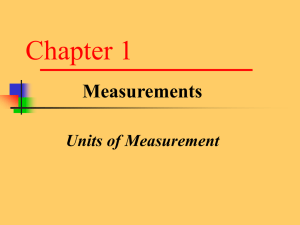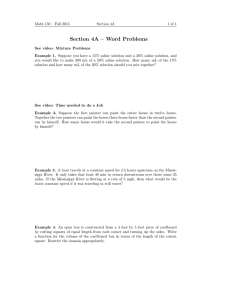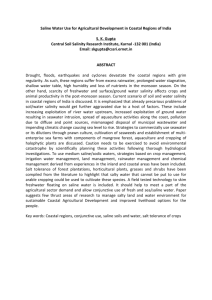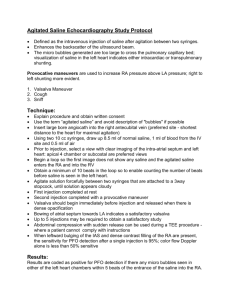International Journal of Application or Innovation in Engineering & Management... Web Site: www.ijaiem.org Email: Volume 4, Issue 3, March 2015
advertisement
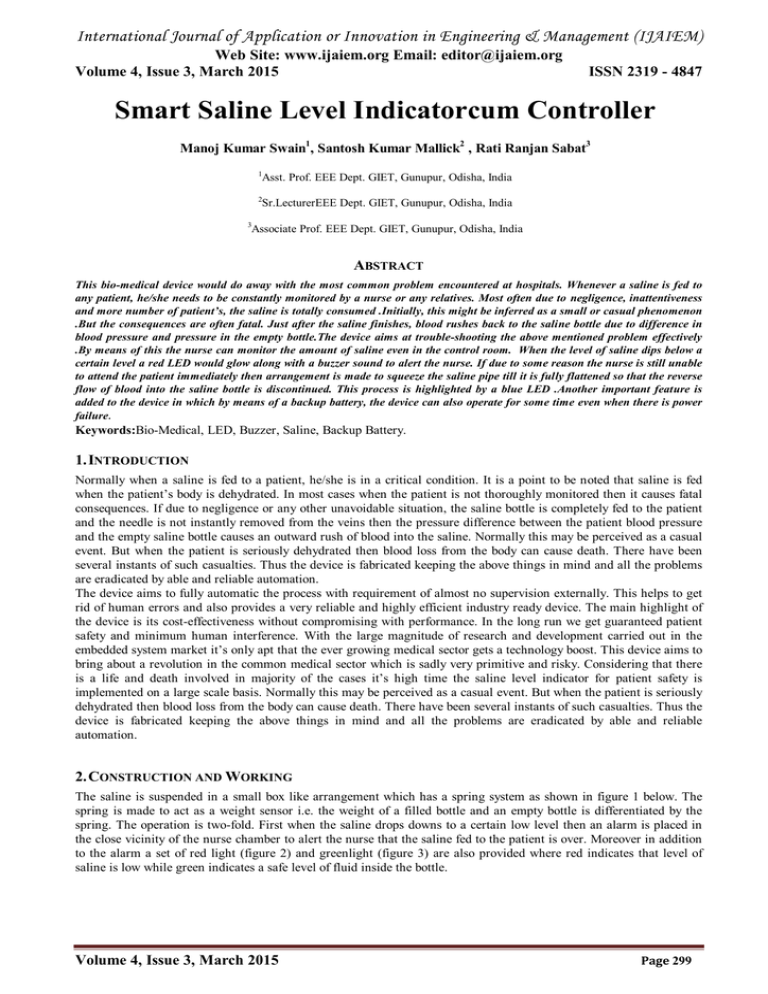
International Journal of Application or Innovation in Engineering & Management (IJAIEM) Web Site: www.ijaiem.org Email: editor@ijaiem.org Volume 4, Issue 3, March 2015 ISSN 2319 - 4847 Smart Saline Level Indicatorcum Controller Manoj Kumar Swain1, Santosh Kumar Mallick2 , Rati Ranjan Sabat3 1 Asst. Prof. EEE Dept. GIET, Gunupur, Odisha, India 2 Sr.LecturerEEE Dept. GIET, Gunupur, Odisha, India 3 Associate Prof. EEE Dept. GIET, Gunupur, Odisha, India ABSTRACT This bio-medical device would do away with the most common problem encountered at hospitals. Whenever a saline is fed to any patient, he/she needs to be constantly monitored by a nurse or any relatives. Most often due to negligence, inattentiveness and more number of patient’s, the saline is totally consumed .Initially, this might be inferred as a small or casual phenomenon .But the consequences are often fatal. Just after the saline finishes, blood rushes back to the saline bottle due to difference in blood pressure and pressure in the empty bottle.The device aims at trouble-shooting the above mentioned problem effectively .By means of this the nurse can monitor the amount of saline even in the control room. When the level of saline dips below a certain level a red LED would glow along with a buzzer sound to alert the nurse. If due to some reason the nurse is still unable to attend the patient immediately then arrangement is made to squeeze the saline pipe till it is fully flattened so that the reverse flow of blood into the saline bottle is discontinued. This process is highlighted by a blue LED .Another important feature is added to the device in which by means of a backup battery, the device can also operate for some time even when there is power failure. Keywords:Bio-Medical, LED, Buzzer, Saline, Backup Battery. 1. INTRODUCTION Normally when a saline is fed to a patient, he/she is in a critical condition. It is a point to be noted that saline is fed when the patient’s body is dehydrated. In most cases when the patient is not thoroughly monitored then it causes fatal consequences. If due to negligence or any other unavoidable situation, the saline bottle is completely fed to the patient and the needle is not instantly removed from the veins then the pressure difference between the patient blood pressure and the empty saline bottle causes an outward rush of blood into the saline. Normally this may be perceived as a casual event. But when the patient is seriously dehydrated then blood loss from the body can cause death. There have been several instants of such casualties. Thus the device is fabricated keeping the above things in mind and all the problems are eradicated by able and reliable automation. The device aims to fully automatic the process with requirement of almost no supervision externally. This helps to get rid of human errors and also provides a very reliable and highly efficient industry ready device. The main highlight of the device is its cost-effectiveness without compromising with performance. In the long run we get guaranteed patient safety and minimum human interference. With the large magnitude of research and development carried out in the embedded system market it’s only apt that the ever growing medical sector gets a technology boost. This device aims to bring about a revolution in the common medical sector which is sadly very primitive and risky. Considering that there is a life and death involved in majority of the cases it’s high time the saline level indicator for patient safety is implemented on a large scale basis. Normally this may be perceived as a casual event. But when the patient is seriously dehydrated then blood loss from the body can cause death. There have been several instants of such casualties. Thus the device is fabricated keeping the above things in mind and all the problems are eradicated by able and reliable automation. 2. CONSTRUCTION AND WORKING The saline is suspended in a small box like arrangement which has a spring system as shown in figure 1 below. The spring is made to act as a weight sensor i.e. the weight of a filled bottle and an empty bottle is differentiated by the spring. The operation is two-fold. First when the saline drops downs to a certain low level then an alarm is placed in the close vicinity of the nurse chamber to alert the nurse that the saline fed to the patient is over. Moreover in addition to the alarm a set of red light (figure 2) and greenlight (figure 3) are also provided where red indicates that level of saline is low while green indicates a safe level of fluid inside the bottle. Volume 4, Issue 3, March 2015 Page 299 International Journal of Application or Innovation in Engineering & Management (IJAIEM) Web Site: www.ijaiem.org Email: editor@ijaiem.org Volume 4, Issue 3, March 2015 ISSN 2319 - 4847 Figure 1Complete arrangement ofSmart Saline Level Indicator cum Controller But inspite of all the above measures it is also possible that the nurse by any chance may not be able attend to the patient immediately and thus our very purpose to make the device fails. Under such circumstances we come to the second part of operation of the circuit. As soon as the alarm is sounded in the nurse chamber a motor arrangement is done which supresses and flattens the saline tube. This prevents the upward flow of saline from the veins to the bottle. Then the nurse or attendant arrives at his own convenience and removes the saline bottle. If any further saline is required by the patient then another saline bottle is placed on the chamber and a reset button is pressed to recur the same process. Figure 2 Normal Level Indicator Figure 3Low Level Indicator The circuit consists a combination of electro-mechanical components .The mechanical part is of a spring which acts as a weight sensor and synchronized with electronic switch. The electronic circuit contains ICs like op-amp, voltage regulator and components like transistors, resistors as shownin figure 4. A filled bottle of saline has more weight while an empty one has less weight. This difference of weight is used to sense the amount of saline present in the bottle and hence is used to provide an audible alarm presentin the indicator board at attender or nurse room. Figure 4 Electronic Circuit Volume 4, Issue 3, March 2015 Page 300 International Journal of Application or Innovation in Engineering & Management (IJAIEM) Web Site: www.ijaiem.org Email: editor@ijaiem.org Volume 4, Issue 3, March 2015 ISSN 2319 - 4847 3. CONCLUSION Smart Saline level indicator for patient safety is a low cost, low power consuming and highly efficient device that can be used for monitoring the amount of saline present in the bottle. It is often noted that there is someone present constantly to monitor the patient fed to a saline as a slight carelessness can cause fatal accidents. The device is a fully automated the process with requirement of almost no supervision externally. This helps to get rid of human errors and also provides a very reliable and highly efficient device for medical use. The main highlight of the device is its costeffectiveness without compromising with performance. In the long run we get guaranteed patient safety and minimum human interference.With the large magnitude of research and development carried out in the embedded system market it’s only apt that the ever growing medical sector gets a technology boost. This device aims to bring about a revolution in the common medical sector which is sadly very primitive and risky. Considering that there is a life and death involved in majority of the cases it’s high time the saline level indicator for patient safety is implemented on a large scale basis. References [1] Hata Y., Komaozaki Y., Sawayama T., Taniguchi K.and Nakajima H. [2007]. “A heart Pulse Monitoring System by Air Pressure and Ultrasonic Sensor Systems”, Proceedings of IEEE System of Systems Engineering, CD-ROM, [2] Ishijima M [1993]. “Monitoring of Electro cardiograms in Bed without Utilizing Body Surface Electrodes”, EEE Transactions on Biomedical Engineering, , 40(6),. [3] “Fundamentals of Electric Circuits” by Charles K. Alexander and Matthew N.O. Sadiku, Fifth Edition, The Mc Graw-Hill Publication. [4] http://www.bipublication.com AUTHORS Manoj Kumar Swain received the B.Tech. and M.tech. Degrees in Electrical and Electronics Engineering from Biju Patnaik University of Technology in 2004 and 2011, respectively. During 2004-2009, he worked asService Engineerin Endorse (Thermax Channel Associate), India And since year 2012 working as Asst. Prof. in EEE Department of GIET, Gunpur, Odisha, India. He has 4 International publications and no.of NationalConferenceand attended various International and National Seminar, Conferences, Conventions. Santosh Kumar Mallick received the B.Tech. Degree in Electrical and Electronics Engineering from Biju Patnaik University of Technology in 2011 andpursuing M.tech. Degree in Electrical Engineering from Biju Patnaik University of Technology. Since year 2012 working as Sr. Lecturer in EEE Department of GIET, Gunpur, Odisha, India. He has 1 International publication and no.of National Conferenceand attended various International and National Seminar, Conferences, Conventions. Rati Ranjan Sabat is Associate professorin Electrical Engineering GIET,He is presently working as Head Of the Department, Electricaland Electronics Engineeringat Gandhi Institute of Engineering and Technology, Gunupur, Odishasince year2005.He received his M.tech. in electrical engineering from BPUT,Rourkela, in 2008 and pesuingPhdin Berhampur University respectively. His area of research in the field of Renewable Energyboth Solar& WindEnergy. 3 publications in National Conference and attended various International and national Seminar,Conferences,Conventions as delegate Volume 4, Issue 3, March 2015 Page 301

